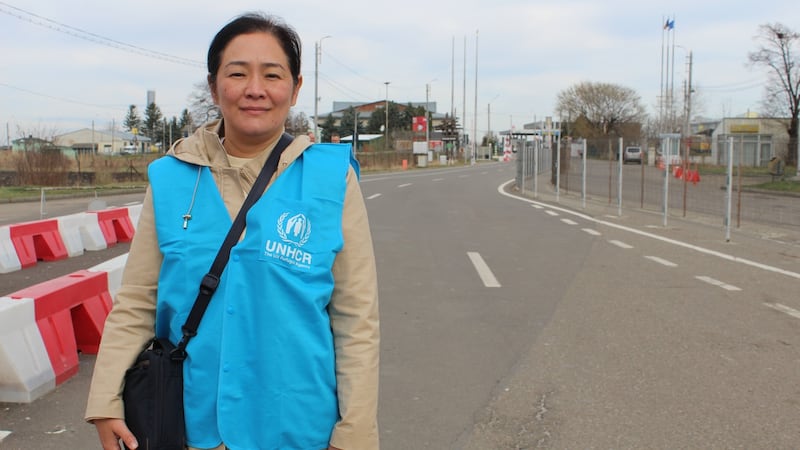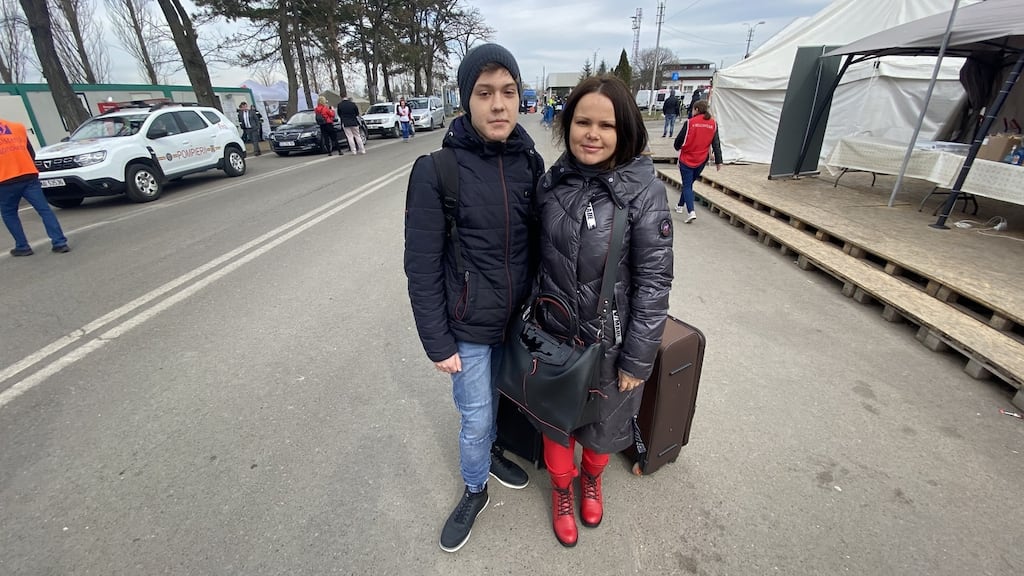"He is a killer," said Alina Serbenyuk of the Russian leader Vladimir Putin after crossing the border into Romania from her home country of Ukraine.
Pulling large wheelie luggage bags behind them, Alina and her son Anton (15) were heading to his older brother’s home in Romania and to safety away from Russia’s bombs.
"Putin is justifying the war by saying that he wants to protect Russia and the Russian people but, on the contrary, he is killing the Ukrainian people and the country of Ukraine," Anton said after crossing the border at Siret in northern Romania. He and his mother left their home in Chernivtsi just across the border because of the risk to residential areas from Russian attacks. He has no idea when they will return.
“We really hope that Putin and everyone else will come to their senses and immediately stop killing people,” he said.
Almost 700,000 Ukrainians have crossed the border into Romania since Russia attacked Ukraine on February 24th. Some 212,000 people have crossed here at Siret, of whom 170,000 have been mothers with children.
Most came in the early weeks of the war from areas where the fighting was heaviest: Kharkiv in eastern Ukraine, Kyiv in the north, and in the south, west along the Black Sea coast to Odesa. In all, more than 4.3 million refugees have left Ukraine with an estimated 6.5 million people displaced within the country. About 80,000 refugees remain in Romania, a Nato and EU state, including 30,000 children. Most travel further afield because of family or work connections.
Aid agencies in Romania expect more refugees arriving in later waves to stay because they will be from rural areas and will want to stay close to their homes.
Chernivtsi, 40km across the border from Siret, is, for now, the safest area in Ukraine. The nearest fighting is still 200km away. This is why 300,000 “internally displaced people” have chosen to flee there from elsewhere in the country, joining the 400,000 people who live in the city, one of western Ukraine’s main cultural centres.
About 2,000 Ukrainians a day are now crossing the border at Siret, down from 6,000 a day in the early weeks of the war. Some consider it safe enough to return, at least temporarily, with 500-600 people travelling back into Ukraine every day.

"You have those who go into Romania for shopping or different economic reasons and then you have those who are exhausted being in a foreign country and they didn't expect to be in a foreign country this long and maybe they're out of cash," Asel Sharsheeva, a protection officer with the United Nations refugee agency, the UNHCR, based at Siret, told The Irish Times.
Those travelling from war-torn parts of Ukraine require psycho-social emergency aid, particularly young people aged 16 and over who can travel without guardians, she said. “All of them are affected,” she said.
Silviu Diaconescu, chief of the border police in Siret, told a group from the Oireachtas EU affairs committee visiting on Thursday, that if Russia attacks Chernivtsi, the numbers coming into Romania at this border crossing would surge to 50,000-60,000 a day.
“For now, there is no pressure,” he said.
But contingency planning is in place in Romania should the Russians attack Chernivtsi or Odesa in the south beyond the border with Moldova. The majority of the refugees arriving into Moldova have travelled on to Romania and further afield.
Most Ukrainian refugees have headed for Poland rather than to Romania because of past work and family connections. Col Dogeanu Marius of Romania's emergency situations department said that if the Russian attacks prevent Ukrainians fleeing to Poland, this would send refugees south to Romania, which has the longest western land border with Ukraine.
“It depends on what the Russian strategy is. If they cut the line to Poland, then they will come here,” he said.
The Siret crossing is well-resourced and well-managed with the road out into Romania lined with international aid agencies and charities to support arriving refugees.
As a safety measure, the Romanians take a record of the names and contact details of people who are picking up refugees to transport them away from the border. For those who stay temporarily in Siret, there is a tented camp that has sheltered 3,700 since the war began.
In preparation for a longer war, the country is bracing itself for a second wave of refugees who will be injured or have lower incomes with no capacity to travel beyond Romania. The government is planning an integration plan for more Ukrainians, beyond the 80,000 already here, to accommodate them into Romanian life and society so as to avoid the creation of “islands” of refugees in the country, a policy that has failed elsewhere in the past.
“The next people coming won’t have a plan B; they will be people in need of support and that is why we have this integration plan in this second phase of intervention,” said Madalina Turza, who is co-ordinating Romania’s humanitarian response from the prime minister’s office.
“Ukraine is not a place to send people back to right now. Seventy per cent are women with two, three, four or five kids – usually small ones. There are so many cities and villages that have been destroyed so you need to rebuild the place and so it is a long-term process.”
Oireachtas EU affairs committee chairman, Fine Gael TD Joe McHugh, who attended meetings with fellow committee members in Romania this week, said that "serious measures" similar to that country's integration plan should be considered in Ireland, particularly given the likelihood of prolonged war in Ukraine with more refugees coming and staying longer.
“We can learn from Romania. This is not just a geographical proximity issue. There’s a massive threat here from Russia and it’s going to be a long-term problem,” he said.











